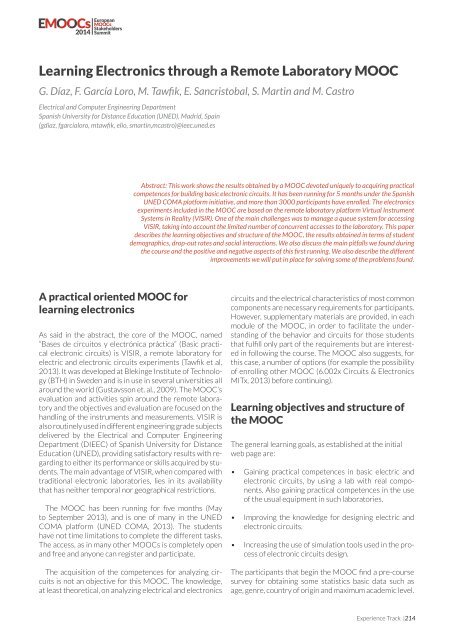zmWmQs
zmWmQs
zmWmQs
You also want an ePaper? Increase the reach of your titles
YUMPU automatically turns print PDFs into web optimized ePapers that Google loves.
Learning Electronics through a Remote Laboratory MOOC<br />
G. Díaz, F. García Loro, M. Tawfik, E. Sancristobal, S. Martin and M. Castro<br />
Electrical and Computer Engineering Department<br />
Spanish University for Distance Education (UNED), Madrid, Spain<br />
(gdiaz, fgarcialoro, mtawfik, elio, smartin,mcastro)@ieec.uned.es<br />
Abstract: This work shows the results obtained by a MOOC devoted uniquely to acquiring practical<br />
competences for building basic electronic circuits. It has been running for 5 months under the Spanish<br />
UNED COMA platform initiative, and more than 3000 participants have enrolled. The electronics<br />
experiments included in the MOOC are based on the remote laboratory platform Virtual Instrument<br />
Systems in Reality (VISIR). One of the main challenges was to manage a queue system for accessing<br />
VISIR, taking into account the limited number of concurrent accesses to the laboratory. This paper<br />
describes the learning objectives and structure of the MOOC, the results obtained in terms of student<br />
demographics, drop-out rates and social interactions. We also discuss the main pitfalls we found during<br />
the course and the positive and negative aspects of this first running. We also describe the different<br />
improvements we will put in place for solving some of the problems found.<br />
A practical oriented MOOC for<br />
learning electronics<br />
As said in the abstract, the core of the MOOC, named<br />
“Bases de circuitos y electrónica práctica” (Basic practical<br />
electronic circuits) is VISIR, a remote laboratory for<br />
electric and electronic circuits experiments (Tawfik et al,<br />
2013). It was developed at Blekinge Institute of Technology<br />
(BTH) in Sweden and is in use in several universities all<br />
around the world (Gustavsson et. al., 2009). The MOOC’s<br />
evaluation and activities spin around the remote laboratory<br />
and the objectives and evaluation are focused on the<br />
handling of the instruments and measurements. VISIR is<br />
also routinely used in different engineering grade subjects<br />
delivered by the Electrical and Computer Engineering<br />
Department (DIEEC) of Spanish University for Distance<br />
Education (UNED), providing satisfactory results with regarding<br />
to either its performance or skills acquired by students.<br />
The main advantage of VISIR, when compared with<br />
traditional electronic laboratories, lies in its availability<br />
that has neither temporal nor geographical restrictions.<br />
The MOOC has been running for five months (May<br />
to September 2013), and is one of many in the UNED<br />
COMA platform (UNED COMA, 2013). The students<br />
have not time limitations to complete the different tasks.<br />
The access, as in many other MOOCs is completely open<br />
and free and anyone can register and participate.<br />
The acquisition of the competences for analyzing circuits<br />
is not an objective for this MOOC. The knowledge,<br />
at least theoretical, on analyzing electrical and electronics<br />
circuits and the electrical characteristics of most common<br />
components are necessary requirements for participants.<br />
However, supplementary materials are provided, in each<br />
module of the MOOC, in order to facilitate the understanding<br />
of the behavior and circuits for those students<br />
that fulfill only part of the requirements but are interested<br />
in following the course. The MOOC also suggests, for<br />
this case, a number of options (for example the possibility<br />
of enrolling other MOOC (6.002x Circuits & Electronics<br />
MITx, 2013) before continuing).<br />
Learning objectives and structure of<br />
the MOOC<br />
The general learning goals, as established at the initial<br />
web page are:<br />
• Gaining practical competences in basic electric and<br />
electronic circuits, by using a lab with real components.<br />
Also gaining practical competences in the use<br />
of the usual equipment in such laboratories.<br />
• Improving the knowledge for designing electric and<br />
electronic circuits.<br />
• Increasing the use of simulation tools used in the process<br />
of electronic circuits design.<br />
The participants that begin the MOOC find a pre-course<br />
survey for obtaining some statistics basic data such as<br />
age, genre, country of origin and maximum academic level.<br />
Experience Track |214


